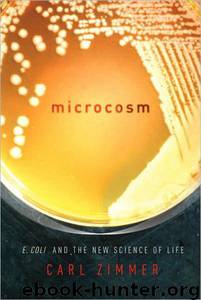Microcosm: E. Coli and the New Science of Life by Carl Zimmer

Author:Carl Zimmer
Language: eng
Format: mobi
ISBN: 037542430X
Publisher: PANTHEON
Published: 2008-05-06T00:00:00+00:00
ASSEMBLING ASSASSINS
Among its many accomplishments, open-source evolution has produced a lot of ways for us to get sick. When Kiyoshi Shiga discovered Shigella, he believed it was a distinct species, and so did generations of scientists who followed him. But when scientists began to examine the genes of Shigella in the 1990s, they realized it was just a particularly vicious form of E. coli. More detailed comparisons revealed that Shigella is actually many separate strains. Many of them are more closely related to harmless strains of E. coli than they are to other strains of Shigella. In other words, Shigella is not a species. It is not even a single strain. It is more a state of being, one that has been achieved by several lineages of E. coli.
Shigella strains typically evolved from less sophisticated parasites. Their ancestors sat on top of the cells of the intestinal wall, injecting molecules into host cells to make them pump out fluids. (Many strains of E. coli still make this sort of living today.) Shigella’s ancestors acquired new genes that allowed them to invade and move inside cells, to escape the immune system and manipulate it. These innovations did not happen in a single lineage of E. coli. They evolved many times over.
Just as important as the genes Shigella gained were the ones it lost. Flagella are wonderful for swimming in the gut, but they are useless inside the crammed interior of a host cell. No Shigella strain can make flagella, although they all still carry disabled copies of the flagella-building genes. Shigella also has disabled copies of genes for eating lactose and other sugars that it no longer feeds on. And it has abandoned an enzyme called cadaverine, which other strains of E. coli make to protect themselves from acid. (Other bacteria produce this foul-smelling substance as they feed on cadavers; hence the name.) For Shigella, cadaverine is a burden because it slows down the migration of immune cells across the wall of the intestines. Shigella depends on immune cells to open up passageways that it can use to get into the intestinal tissue and invade cells. As a result, one of the genes essential for making cadaverine has been disabled in every strain of Shigella.
Other strains of E. coli have evolved into different sorts of pathogens, and their genomes still record that transformation. Horizontal gene transfer, lost genes, and natural selection all were at play in their histories as well. Scientists who study E. coli O157:H7, the strain that can be carried in spinach or hamburgers, have done a particularly good job of reconstructing its evolution step by step. Its ancestors started out as far gentler pathogens, but about 55,000 years ago, they began to be infected with a series of viruses, each installing a new weapon in its arsenal. The devastating toxin that makes E. coli O157:H7 so dangerous, for example, is encoded on a gene that lies nestled among the genes of a virus. The virus is such a recent arrival in the E.
Download
This site does not store any files on its server. We only index and link to content provided by other sites. Please contact the content providers to delete copyright contents if any and email us, we'll remove relevant links or contents immediately.
| Cell Biology | Developmental Biology |
| Entomology | Marine Biology |
| Microbiology | Molecular Biology |
| Biostatistics |
Sapiens: A Brief History of Humankind by Yuval Noah Harari(14248)
The Tidewater Tales by John Barth(12608)
Mastermind: How to Think Like Sherlock Holmes by Maria Konnikova(7225)
Do No Harm Stories of Life, Death and Brain Surgery by Henry Marsh(6887)
The Thirst by Nesbo Jo(6826)
Why We Sleep: Unlocking the Power of Sleep and Dreams by Matthew Walker(6618)
Life 3.0: Being Human in the Age of Artificial Intelligence by Tegmark Max(5474)
Sapiens by Yuval Noah Harari(5293)
The Longevity Diet by Valter Longo(5017)
The Body: A Guide for Occupants by Bill Bryson(4974)
The Rules Do Not Apply by Ariel Levy(4852)
The Immortal Life of Henrietta Lacks by Rebecca Skloot(4525)
Animal Frequency by Melissa Alvarez(4394)
Why We Sleep by Matthew Walker(4359)
The Hacking of the American Mind by Robert H. Lustig(4318)
Yoga Anatomy by Kaminoff Leslie(4303)
All Creatures Great and Small by James Herriot(4231)
Double Down (Diary of a Wimpy Kid Book 11) by Jeff Kinney(4206)
Barron's AP Biology by Goldberg M.S. Deborah T(4096)
